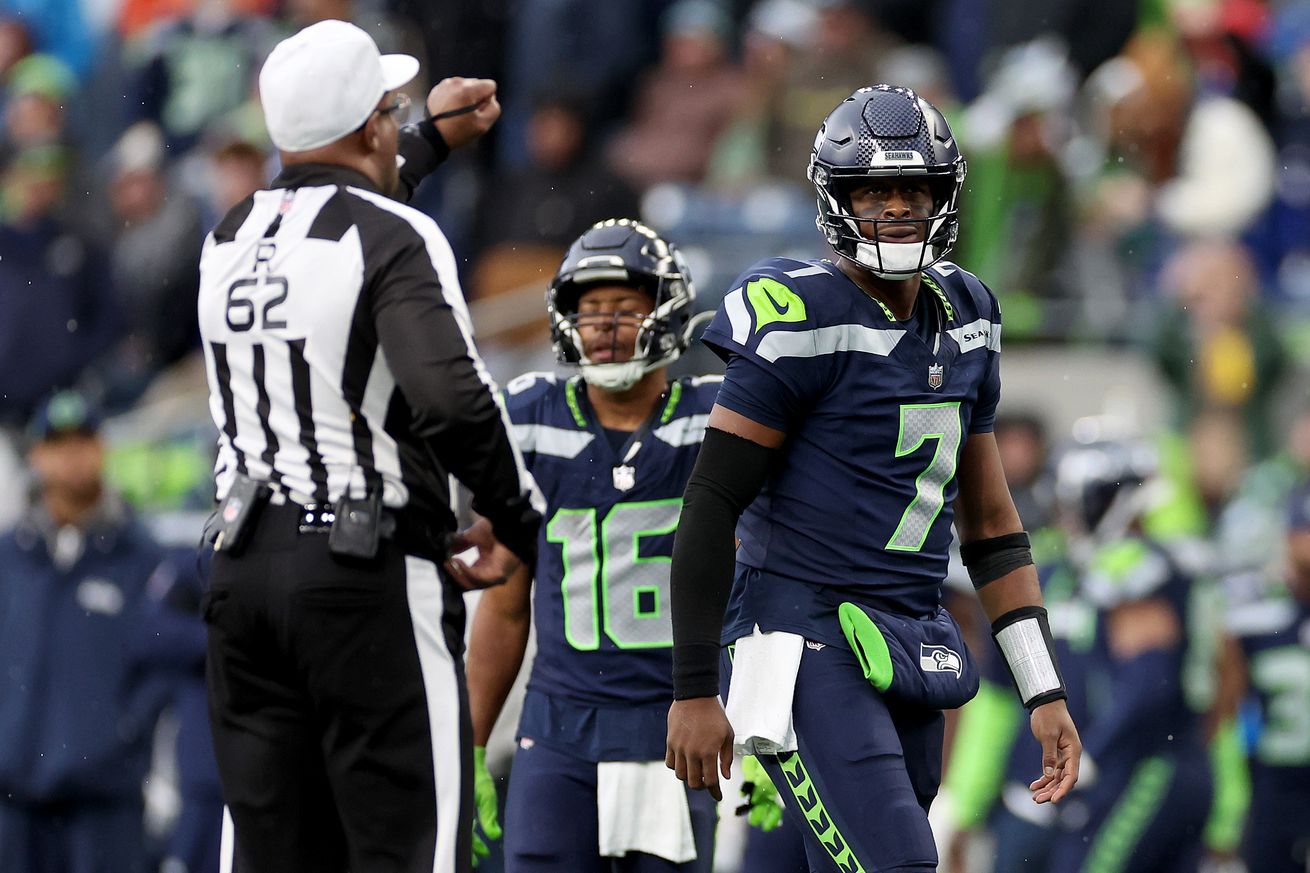
Ron Torbert had a very busy night
It’s not often that the data entry for an article becomes mentally draining, but here we are. It’s a fun fact that my spreadsheet is color coded by team and my mental health perhaps wasn’t helped by choosing to flag this game with the Seattle Seahawks “Action Green.” Anyway, the Buffalo Bills and Seahawks combined for a preposterous 32 flags (24 assessed). Roughly one out of every six snaps had a flag. There were four in row in the third quarter, all on Seattle. I could keep rattling off how insane it was, but you likely watched it and know already.
Standard and Advanced Metrics
Penalty Counts
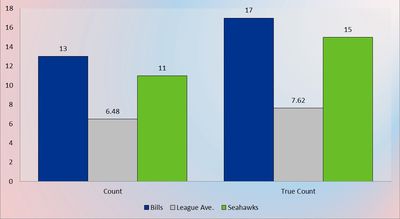
Just look at this nonsense. Do I even need to say anything? These charts are about as obvious as it gets. I guess I’ll say one thing. Depending on where you’re grabbing information from, the illegal shift on Buffalo (more on that in a minute) may or may not be counted. The spirit of true count is to examine every infraction that occurs for trending, so of course I counted it.
Penalty Yards
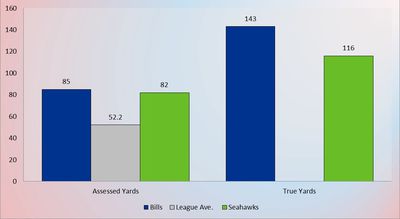
What makes this chart fun is that the left-hand side doesn’t look too terrible until you realize that the right side is so out of control it only looks kind of normal. At this point I’ll start introducing you to a narrative shift that I think the data supports. While it certainly could be said that Buffalo got a bit lucky with some freakish mistakes by Seattle, maybe the Seahawks were a bit lucky too.
Penalty Harm
Seattle Seahawks
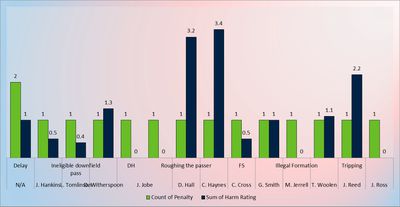
This **** is so bad that penalty names are lopped off in the chart because of course I don’t have the formatting optimized for this many flags by one team. I would have rectified this but I felt the Seahawks needed to be taught a lesson. You sit there and think about what you did Seattle!
Surprisingly, the Seahawks only had 14.6 Harm in total, which is on the wrong side of the bad day line, but not as bad as I was expecting. Rather than try to highlight specific flags this week, I felt we could go a different direction that there’s not often enough data to justify. You’ll see what I mean in a moment, but first let me know if there’s a call you want more info on in the comments. I don’t recall anything all that controversial in the grand scheme of things, but I’m happy to revisit if someone wants.
This week there’s enough flags to warrant a change of pace. I track items that are more appropriate for season aggregates, but what the heck, let’s do it for a single game. I usually briefly talk about the impacted yards a little more thoroughly. Seattle’s 34 yards negated came on only three plays. The least impactful was 12 yards wiped out on the tripping call on a late Buffalo punt. The game was effectively over and even a chunk of yards at the very start of a drive isn’t always a death knell.
For the other two plays, they negated a 14-yard gain and an eight-yard sack, neither of which are remotely a good thing for a team that also had the center essentially hand Buffalo two stops. On the 14-yard problem, it also negated a first down from second, impacting one down. Similarly, the roughing-the-passer call gave up two downs (free first down from third).
Speaking of that roughing-the-passer call, it invoked the very rarely seen “5 vs. 15 enforcement.” I’ve often seen fans lament when flags offset that “this one was worse, they shouldn’t just cancel each other out.” The 5 vs. 15 enforcement rule is exactly that concept. While most penalties will offset with each other, it’s not the case when they’re too far apart. By definition, the “too far apart” is when one flag would be assessed as a five-yarder, and the other team has a 15-yarder.
In that scenario, the easiest way to describe the 5 vs. 15 enforcement is that in these situations the fiver is “disregarded.” That’s the actual word from the rule book and is the wording for offsetting flags. The other way to say is “pretend it didn’t happen.” It’s a rare rule but for us penalty nerds there’s an even more important implication on this beyond the simple criteria.
Specifically, this carries over into the idea of a “free play.” Buffalo was flagged for an illegal shift. The defense has a “free play” right? Sorta. If they forced a major negative for the Bills (interception, sack) they can decline the fiver. That means you can play a little looser and go for the big play. However, if you play too loose and smack Josh Allen in the noggin, you can invoke the wrath of an exceedingly rare enforcement rule.
Buffalo Bills
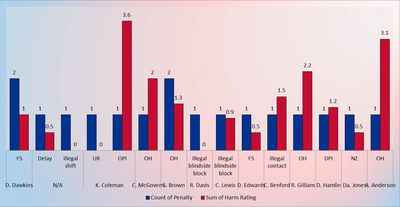
Remember I said I’d introduce a narrative twist above. Yes quarterback Geno Smith tripped at the goal line. Yes, Buffalo benefited from literally the highest snap that’s ever existed. What about the flip side? The Bills amassed 18.3 Harm, a decently worse day than Seattle in the flag department.
Buffalo negated a ludicrous 58 yards in this game due to penalty. Wide receiver Keon Coleman negated a 22-yard catch of his own via offensive pass interference. The Bills’ offense also wiped out yards due to offensive holding flags on four separate occasions for a total of 36 yards.
Buffalo also impacted downs with four flags. Coleman’s OPI was one of those. The Bills negated a first down via holding, and gave Seattle a free down twice via an illegal-contact call and a defensive-pass-interference one.
What I’m getting at is that Seattle repeatedly shot themselves in the foot during the game. Some of it was penalties, the topic of this article, but there were a couple non-flag blunders to boot. If we’re keeping a tally of the two teams, Buffalo made it a close race. When it comes to strictly flags, there’s pretty good proof right above that the Bills outpaced the Seahawks when it comes to blunders.
Put differently, it’s absolutely true that a clean game likely allows Seattle to play it closer and who knows, maybe pull out a win. However, a clean game from Buffalo is even more of a rout than what occurred.